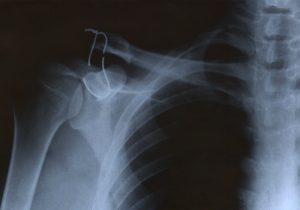 A clavicle fracture, more commonly known as a broken collarbone, is a common injury and one that is most often the result of a hard blow or fall. Athletes who participate in contact sports are highly likely to suffer from broken collarbones; however, clavicle fractures are also common in car accident victims. This is especially true of people who incorrectly wear their seatbelts. There have even been incidents in which newborns have sustained broken collarbones from passing through the birth canal.
A clavicle fracture, more commonly known as a broken collarbone, is a common injury and one that is most often the result of a hard blow or fall. Athletes who participate in contact sports are highly likely to suffer from broken collarbones; however, clavicle fractures are also common in car accident victims. This is especially true of people who incorrectly wear their seatbelts. There have even been incidents in which newborns have sustained broken collarbones from passing through the birth canal.
While broken collarbones occur in a wide variety of people and stem from many situations, the symptoms of a fractured clavicle are the same. A broken collarbone is an obvious injury and a crack is usually heard when the bone breaks. Afterwards, if your collarbone is broken you will have some of the following symptoms:
- Swelling and pain in the area
- Difficulty moving your arm and shoulder
- Grinding when raising your arm
- Shoulder sagging
- A swollen bump around the area of the injury
If you have any of these symptoms after suffering a hard blow or fall, visit a doctor’s office for a full physical exam and X-rays. These procedures will help a doctor diagnose you and confirm that your collarbone is, in fact, broken. What are the next steps to take once you are diagnosed with a broken collarbone? There aren’t many things you can do to speed up the healing process, but there are steps to take to ensure that the healing process goes as smoothly as possible.
Steps to Take After Suffering a Broken Collarbone
After you’ve visited a doctor and they’ve diagnosed you with a broken collarbone, it is a waiting game as you heal. Most of the time a broken collarbone heals on its own and all you can do is wait; however there are some ways to help speed up the healing process.
Splint or Brace Your Shoulder
Applying a splint or brace to the shoulder that is on the same side as the broken collarbone can help with the healing process. The bone will need to fuse back together in order to mend itself and limited mobility is the best way for that process to happen. When you apply a splint or a brace to the shoulder in question, you’re preventing unnecessary movement from disrupting the break.
Sling Your Arm
Getting your arm into a sling is another way to help speed up the healing process for a broken collarbone. With your arm in a sling, there will be little to no pressure to support the weight of your arm. This will allow your shoulder to relax and the broken collarbone will quickly start to fuse together. It is important to note that you won’t want to use the sling for more than just a few days.
Treat Pain with OTC Painkillers
Anti-inflammatory painkillers aren’t going to help speed up the healing process, but they will help with pain management as your collarbone heals. Over the counter (OTC) painkillers such as Ibuprofen and other aspirins will help ease pain and swelling in the injury area. Be careful on dosages though as painkillers have side effects that include increased risk of ulcers and bleeding. Check with your doctor prior to starting a pain management regimen.
Participate in Physical Therapy
Physical therapy is a strenuous part of recovery from any injury, but it is also so important to practice strengthening exercises and improve your range-of-motion slowly. Physical therapy exercises will help to strengthen the weakened collarbone and also increase your chances of avoiding a re-injury.
Whether you practice some of these tips on speeding up the healing process or not, it will take anywhere from 6 to 12 weeks for your broken collarbone to fully heal. In some cases, you may need to consider surgery to completely fix a broken collarbone. This is especially true if ligaments were also damaged when the break occurred. Regardless of surgery and healing time, it is important to take it easy when returning to physical activity. Collarbones are extremely susceptible to suffering from re-breaks. This means it is especially important to exercise caution when participating in sporting events and exercise routines.
If you have suffered from a broken collarbone and are still experiencing pain, contact Dr. Stacie Grossfeld today. Dr. Grossfeld is a double board-certified orthopedic surgeon by the American Board of Orthopedic Surgery with a specialty in sports medicine. She has a special interest in knee and shoulder reconstructions, shoulder injuries, and is currently accepting new patients. Contact Dr. Grossfeld at Orthopaedic Specialists today by calling 502-212-2663 or visiting one of her two office locations in Louisville, Kentucky.

Recent Comments